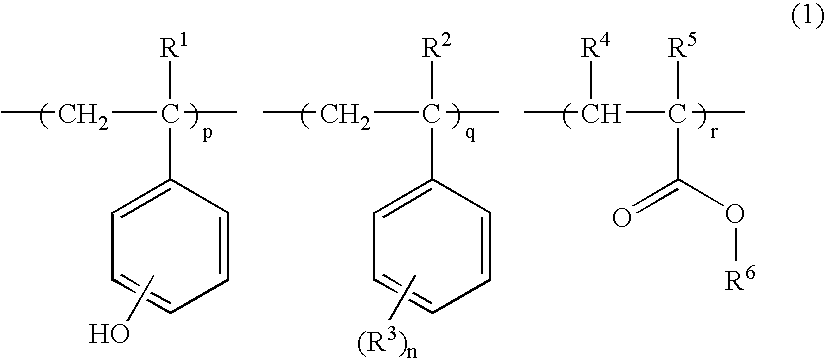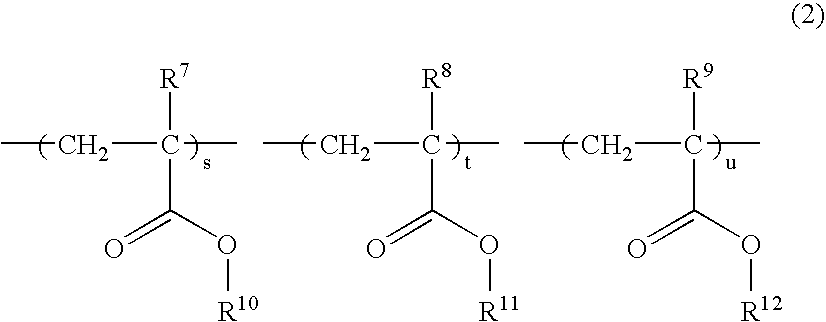Resist polymer, making method, and chemically amplified positive resist composition
a technology of resist polymer and composition, applied in the direction of photosensitive materials, instruments, photomechanical equipment, etc., can solve the problems of insufficient resolution and inadequate polymerization into polymers for photoresist use, and achieve the effects of improving the contrast of resist film dissolution, resolution, and reducing the roughness of line edges
- Summary
- Abstract
- Description
- Claims
- Application Information
AI Technical Summary
Benefits of technology
Problems solved by technology
Method used
Image
Examples
synthesis example 1
[0110] To a 2-L flask were added 42.7 g of acetoxystyrene, 3.3 g of styrene, 14.0 g of t-butyl methacrylate, and 120 g of tetrahydrofuran (THF) as a solvent. The reactor was cooled to −70° C. in a nitrogen atmosphere, whereupon vacuum deaeration and nitrogen flow were repeated three times. The reactor was warmed up to room temperature, 6.7 g of organotellurium compound (3-2) was added as a polymerization initiator, and the reactor was further heated to 60° C., at which reaction was effected for 15 hours. The reaction solution was concentrated to a one-half volume and poured into a mixture of 4.5 L of methanol and 0.5 L of water for precipitation. The resulting white solids were filtered and vacuum dried at 60° C., obtaining 56 g of a white polymer. The polymer was dissolved again in a mixture of 0.5 L of methanol and 1.0 L of THF, to which were added 70 g of triethylamine and 15 g of water. Deblocking reaction was effected, followed by neutralization with acetic acid. The reaction s...
synthesis example 2
[0127] To a 2-L flask were added 41.4 g of acetoxystyrene, 18.9 g of 1-ethylcyclopentyl methacrylate, and 120 g of THF as a solvent. The reactor was cooled to −70° C. in a nitrogen atmosphere, whereupon vacuum deaeration and nitrogen flow were repeated three times. The reactor was warmed up to room temperature, 6.3 g of organotellurium compound (3-2) was added as a polymerization initiator, and the reactor was further heated to 60° C., at which reaction was effected for 15 hours. The reaction solution was concentrated to a one-half volume and poured into a mixture of 4.5 L of methanol and 0.5 L of water for precipitation. The resulting white solids were filtered and vacuum dried at 60° C., obtaining 53 g of a white polymer. The polymer was dissolved again in a mixture of 0.5 L of methanol and 1.0 L of THF, to which were added 70 g of triethylamine and 15 g of water. Deblocking reaction was effected, followed by neutralization with acetic acid. The reaction solution was concentrated ...
synthesis example 3
[0133] To a 2-L flask were added 41.2 g of acetoxystyrene, 13.0 g of 4-t-butoxystyrene, 5.8 g of t-butyl methacrylate, and 120 g of THF as a solvent. The reactor was cooled to −70° C. in a nitrogen atmosphere, whereupon vacuum deaeration and nitrogen flow were repeated three times. The reactor was warmed up to room temperature, 6.5 g of organotellurium compound (3-2) was added as a polymerization initiator, and the reactor was further heated to 60° C., at which reaction was effected for 15 hours. The reaction solution was concentrated to a one-half volume and poured into a mixture of 4.5 L of methanol and 0.5 L of water for precipitation. The resulting white solids were filtered and vacuum dried at 60° C., obtaining 51 g of a white polymer. The polymer was dissolved again in a mixture of 0.5 L of methanol and 1.0 L of THF, to which were added 70 g of triethylamine and 15 g of water. Deblocking reaction was effected, followed by neutralization with acetic acid. The reaction solution ...
PUM
| Property | Measurement | Unit |
|---|---|---|
| Length | aaaaa | aaaaa |
| Flexibility | aaaaa | aaaaa |
| Surface roughness | aaaaa | aaaaa |
Abstract
Description
Claims
Application Information
 Login to View More
Login to View More - R&D
- Intellectual Property
- Life Sciences
- Materials
- Tech Scout
- Unparalleled Data Quality
- Higher Quality Content
- 60% Fewer Hallucinations
Browse by: Latest US Patents, China's latest patents, Technical Efficacy Thesaurus, Application Domain, Technology Topic, Popular Technical Reports.
© 2025 PatSnap. All rights reserved.Legal|Privacy policy|Modern Slavery Act Transparency Statement|Sitemap|About US| Contact US: help@patsnap.com



